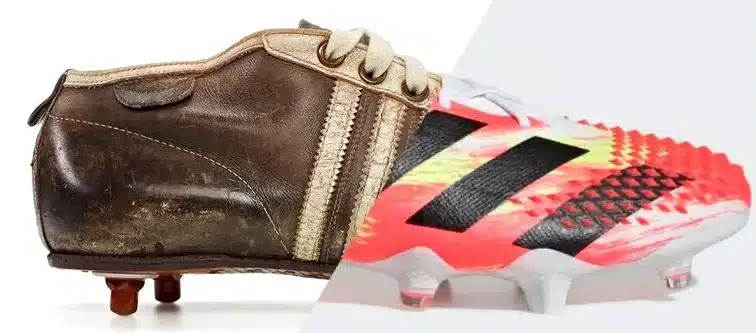The Evolution of Soccer Cleats
Soccer, also known as football in many parts of the world, is a sport that requires a combination of skill, speed, and agility. One of the most crucial pieces of equipment for soccer players is their footwear, specifically soccer cleats. These specialized shoes are designed to provide players with the necessary grip and traction on the field, allowing them to make quick and precise movements. In this article by fcscout.com, we will explore the history and evolution of soccer cleats, from their humble beginnings to the modern-day designs used by professional players around the world.

Early History of Soccer Cleats
The origins of soccer cleats can be traced back to the early 19th century, when soccer was first gaining popularity in Europe. At that time, soccer shoes were not much different from regular everyday shoes, with no special features or designs to help players perform better on the field. In fact, some early soccer players even played in their regular work boots, which provided little to no traction on the grass surface.
As soccer became more organized and standardized, the need for specialized footwear became apparent. The first designs of soccer cleats were inspired by the boots worn by rugby players, who had been using cleats to improve their grip on the muddy fields. Soccer cleats featured leather uppers, with small metal or leather studs attached to the sole for traction. These early designs were crude and uncomfortable, with little consideration given to player comfort or safety.
Over time, soccer cleats underwent several changes in design and materials. In the 1950s, manufacturers began experimenting with synthetic materials, such as nylon and rubber, which were lighter and more durable than leather. The studs also became more varied in shape and size, depending on the type of surface they were designed to be used on. Some soccer cleats featured screw-in studs, allowing players to adjust the length of their studs depending on the field conditions.
Modern Soccer Cleats
Today, soccer cleats have evolved into high-tech pieces of equipment, with designs and features that are tailored to meet the specific needs of different players and playing surfaces. Innovations in materials and technology have allowed soccer cleats to become lighter, more comfortable, and more responsive than ever before.
One of the biggest changes in modern soccer cleats is the use of synthetic materials, such as microfiber and mesh, which are more breathable and provide better support and stability than traditional leather. Soccer cleats now feature advanced cushioning and shock-absorption technologies, which reduce the impact of the player’s movements on their feet and joints.

Different types of soccer cleats are now available, each designed to provide the best performance on different playing surfaces. For example, firm ground (FG) cleats are designed for natural grass surfaces, while soft ground (SG) cleats are designed for wet or muddy surfaces. Turf shoes and indoor soccer shoes are designed for artificial surfaces and indoor courts, respectively.
The competition between brands has also led to significant innovation in soccer cleat design. Brands such as Nike, Adidas, Puma, and Under Armour are constantly pushing the boundaries of technology and design to create the best possible soccer cleats for players. Nike, for example, has developed Flywire technology, which uses ultra-thin strands of high-strength fibers to provide a lightweight and flexible upper that still provides support and stability. Adidas has introduced Boost technology, which uses thousands of tiny capsules of energy-returning material to provide a responsive and comfortable sole.
The future of soccer cleats looks bright, with more advances in technology and design on the horizon. 3D printing, for example, could allow for the creation of customized soccer cleats that are tailored to the individual player’s foot shape and playing style. Wearable technology, such as sensors that track a player’s movement and performance, could also be integrated into soccer cleats, providing players and coaches with valuable data to improve their game.
Conclusion
In conclusion, soccer cleats have come a long way since their early origins in the 19th century. From simple leather boots with metal studs to high-tech, customizable pieces of equipment, soccer cleats have evolved to become an essential part of the game. Innovations in materials and design have led to lighter, more comfortable, and more responsive soccer cleats, while competition between brands has driven significant innovation in the industry.
The future of soccer cleats looks exciting, with even more advances in technology and design on the horizon. With the right pair of soccer cleats, players can have the confidence and support they need to take their game to the next level.
EXPLORE MORE CLUBS!
Explore more professional clubs by continent.






